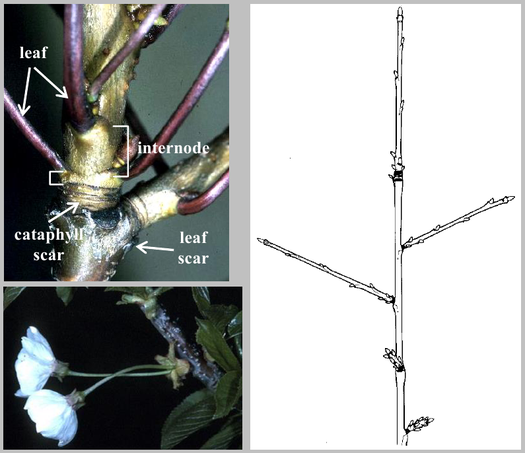Preliminary Course
Botany. Architectural Analysis
An Example.
Wild Cherry Tree (young stage)
-
Architectural Analysis of the Wild Cherry (Prunus avium L. Rosaceae)
Seedling and young stage
Under nursery conditions seedlings present an unbranched stem bearing, above pulpy cotyledons, spiral alternate entire leaves with two stipules at the base of the petiole.
Each year the apical meristem produces an axis portion which, from the base to the top, bears in succession a series of cataphylls, abortive leaves, green leaves with axillary buds and finally some small leaves without visible axillary buds.
In Wild Cherry, cataphyll scars marking the limit between two successive annual shoots (see fig. 1) may remain visible on the bark of axes for as long as 10 to 20 years.
On a young tree, annual shoots normally appear in one single flush of growth, although under good growth conditions two, or more rarely three, successive flushes of growth (respectively named 'spring shoot', 'shoot of Saint-John' and 'August shoot' according to their time of occurrence) may be observed.
Axillary buds give rise to long shoots in their upper part and to short shoots in their lower part (see fig. 2) the year following the development of an annual shoot.
As for most forest species native to temperate areas, branching is thus delayed by one year (i.e. branching is proleptic).
As the tree grows, the annual shoots of the main stem bear bigger and more ramified branches in a distal position, whereas short lateral axes develop in a proximal position.
Flowering
In the open field, the first flowering occurs on three to four-year-old trees.
Inflorescences are borne on short shoots and the most proximal part of long one-year-old shoots (fig. 3).
Each leaf node of a short shoot may bear a lateral inflorescence while only the first leaves of long shoots do so.

Prunus avium young stage and close ups (Y. Caraglio, CIRAD)
Top Left: Figure 1. Morphological markers resulting from tree growth.
Scars of cataphylls associated with short internodes indicate the winter halt in growth.
Right: Figure 2. Structure of a two-year-old stem portion.
Bottom Left: Figure 3. Lateral inflorescence.
